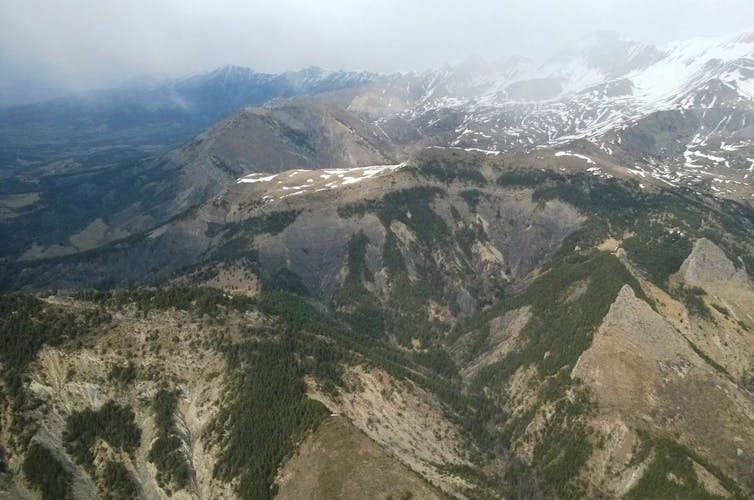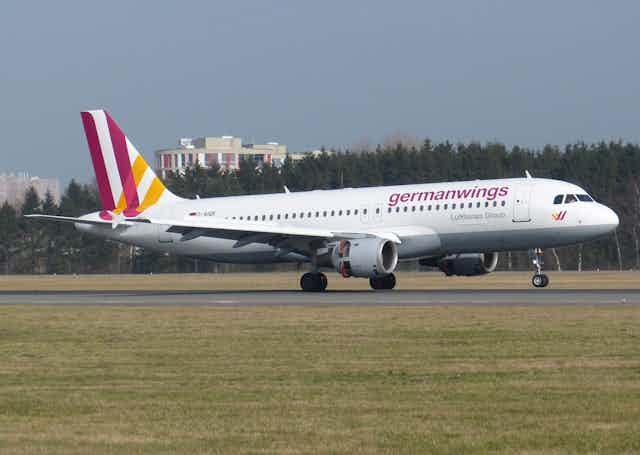We climbed out over the Mediterranean after take-off from Barcelona, veered off the Spanish coast, and pointed the nose northeast. Soon we’d be talking to controllers in Marseille and make landfall near Toulon. From there onward, sometimes taking a morsel of Italy, often across Switzerland, then further north, to our base in Copenhagen.
Although a full-time professor, I was flying part-time as a co-pilot for an airline much like Germanwings. We’d typically fly Copenhagen-Barcelona back and forth, briefing the two flights in the crew room beforehand: route, times, crew members for the trip, equipment and instruments, weather, fuel, winds aloft, expected turbulence.
In good visibility we could follow the Rhein river and see ancient towns -— Worms, Heidelberg and Freiburg -— and fields, forests, roads and mountains glide underneath us peacefully. Peering down at them from some 40,000 feet was one of the greatest aspects of my side job.
On the home-bound leg, after leaving Barcelona, the French coastline would swim into view only reluctantly, freeing itself from the haze of a placid spring or summer Mediterranean.
And behind it -— formidably, massively -— the Alps.

Navigating through the Alps
The Alps always were a forbidding obstacle, or praised protective barrier, for Europeans.
In 218 BCE, Hannibal, whose elephants weighed only about a tenth of our Boeing, had his own share of emergencies on his way to Rome. He lost many pack animals and supplies during a clash with barbarians in a pass near Mt du Chat.
But Hannibal lived on different time constants. His response to the emergency was to march into Chambery, strip it of its horses, beasts of burden, food and supplies, and then burn the town.
Today, the remains of Germanwings 4U9525 lie not far from where Hannibal is likely to have crossed.
The crashed Airbus 320 was travelling from Barcelona, in Spain, to Duesseldorf, in Germany, with six crew members and 144 passengers on board, including two Australians.
The causes of the accident are under investigation.
But if there was an emergency on board a flight like that, the time constants and pressures would be very different. A dire emergency over the Alps would be a pressurisation problem, particularly a sudden one.
Emergency onboard an aircraft
Airplane cabins do not get fed oxygen from bottles. Rather, normal outside air is brought in and pressurised so that its density makes it breathable and livable.
Pressurisation systems can fail, though they seldom do. A sudden decompression is one of those rare, extremely low-probability/high-consequence events for which it is hard to maintain meaningful proficiency. Particularly because there is much to do, so many things to coordinate, with so little margin of error and few alternative options.
If the cabin pressure goes, you grab and don your oxygen mask, flick switches so as to establish communications through the mask, and then you have to get the aircraft down.
Suppress the loud warning horn if you can. In the back, masks will have dropped automatically to provide chemically generated oxygen for passengers and cabin crew for the next minutes.
The drill needs to go by heart, and quickly:
- Oxygen masks and regulators: on, 100% oxygen
- Crew communications: establish
- Pressurisation mode selector: manual
- Outflow valve: close
- Passenger signs: on
- Passenger oxygen: on
- Emergency descent: initiate.
The cockpit masks inflate around the pilot’s head. They are like an emergency clamp—- squeezing, claustrophobic, with baffles and flaps seeming to live deep inside to get you the oxygen you need, or more, with which you need to learn to breathe in tandem.
Before descending, you try to point the airplane’s nose off the airway, or flight corridor, so that you don’t get in the way of other airplanes flying below.
The drill continues, still by heart, and it’d better go like clockwork. One crewmember calling out, the other doing what needs doing, confirming with the exact right responses:
- Emergency descent: announce
- Engine start switches: continuous
- Thrust levers: close
- Speedbrake: flight detent
- Descent: initiate
- Target speed.
Letting air traffic control know what’s going on comes in a very distant second place – if there is time and cognitive space to do so at all.
Descending at some 3,000 feet per minute, it takes about 10 minutes to get down to 10,000ft from cruise. This is not a plunge, it is a controlled descent. At 10,000 feet, everybody can breathe without masks.
So that’s the goal. Get to 10,000 feet. Take the masks off. Figure out where to go next, where to land. Indeed, talk to a controller.
Hazards of flying low
But in the Alps, some 500 mountains rise above 10,000 feet. You can’t just go anywhere. This is where minimum altitudes come in.
Minimum sector altitude (MSA), minimum en-route altitude (MEA), minimum obstacle clearance altitude (MOCA), minimum off-route altitudes (MORA), minimum crossing altitude (MCA) -— numbers scattered across paper charts (or today, iPads) in the cockpit, based on assumptions about the density and temperature of the atmosphere that are probably not valid that day.
Minimum altitude routes through mountain ranges, or Grand Massifs like the Alps, are hard to remember in detail from briefings. It’s a lot to keep stable in the head for an event that you have come to believe will “never” happen.
I look forward to the day that such routes pop up automatically on my moving map display in case of emergency. Today, they don’t. On a US$60 million jet, with a display whose hardware alone is over US$100,000, who’s counting?
Germanwings 4U9525 ended up at about 6,000 feet. When you’re that busy, and descending at that rate, it wouldn’t be hard to punch through the desired altitude for a bit.
Something else may have happened altogether, of course. We will hopefully know soon. If the history of aviation and accident investigations has shown anything, it is that we are willing —- keen even —- to learn from things that go wrong.
This might include finding better ways to know about the places in mountainous terrain where we can breathe, but also stay alive by not hitting anything.

